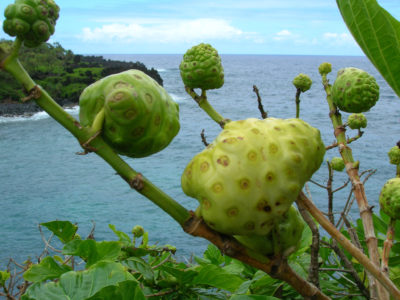
Great morinda - Photo by Forest and Kim Starr
Fruits of the Great morinda can be eaten raw or is used in cooking (for example in curry. Seeds can be eaten when roasted. Leaves can be used as a green vegetable.
Great morinda is a fruit related to coffee.
Names
Scientific
Morinda citrifolia
English
Beach mulberry
Cheese fruit
Great morinda
Indian mulberry
Noni
Dutch
Indische moerbei
Noni
Spanish
Fruta del diablo
Mora de la India
Noni
French
Nono
Pomme-chien
German
Indischer Maulbeerbaum
Indischer Maulbeerstrauch
Noni
Noni-Baum
Italian
Gelso indiano
Noni
Nonu
Taxonomy
Order
Gentianales
Family
Rubiaceae
Genus
Morinda
Species
Morinda citrifolia (Great morinda)
Basic information and facts
Origin:
Great morinda originates from South East Asia and Australasia.
Distribution:
Common in tropical countries.
Evergreen or deciduous:
It’s an evergreen tree.
Plant:
Grows as a bush or small tree.
Leaves:
Fruits:
Climate and weather:
Grows in tropical climates.
Pollination:
Height:
These small trees can reach a height of up to 6 meters.
Spacing:
Propagation:
Uses:
Great morinda fruits are eaten raw or are used in cooking (e.g. in curries. The seeds can be eaten when roasted. Leaves can be used as a green vegetable. The bark is used to make a brownish-purplish dye that can be used to dye cloth or for making batik.
Crop categories
Dye crops
Fruits
Subtropical crops
Tropical crops
Wild-harvested crops
Pictures

Great morinda - Photo by Forest and Kim Starr

Great morinda - Photo by Roberto Verzo

Noni or Great morinda - Photo by Scot Nelson

Great morinda - Photo by Scot Nelson

Great morinda - Photo by Wendy Cutler
